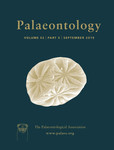Reg. Charity No. 1168330

Electron backscatter diffraction (EBSD) is a useful tool for gathering crystallographic information from carbonate biominerals because it maps out the orientation of crystal grains very precisely. EBSD has become popular in invertebrate palaeontology but its application in vertebrate palaeontology remains limited. However, the study of fossil eggshells is a field where EBSD has wide potential applicability and provides a quantitative approach to fossil eggshell research as well as new qualitative data. Here we analyse fossil and extant maniraptoran dinosaur eggshells using EBSD analysis emphasizing four different aspects. The mapping imaging clarifies previously ambiguous characters such as squamatic ultrastructure and allows a more objective evaluation of avian and non‐avian maniraptoran eggshell. In particular, our results imply that the presence of an external zone in the manirpatoran eggshell is not diagnostic of avian eggshell. EBSD analysis can be also used for differentiating true pore canals from cracks in the eggshell radial section, thereby determining the biological genuineness or otherwise of a pore‐like structure. Finally, the misorientation angle distribution of the material shows a clear dichotomy that may reflect reproductive brooding strategy, although further studies on contact incubation of palaeognaths and neognaths are needed to confirm this.